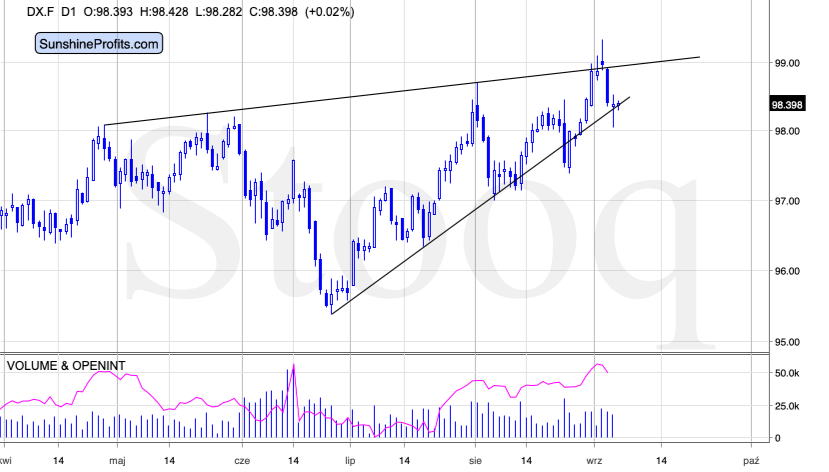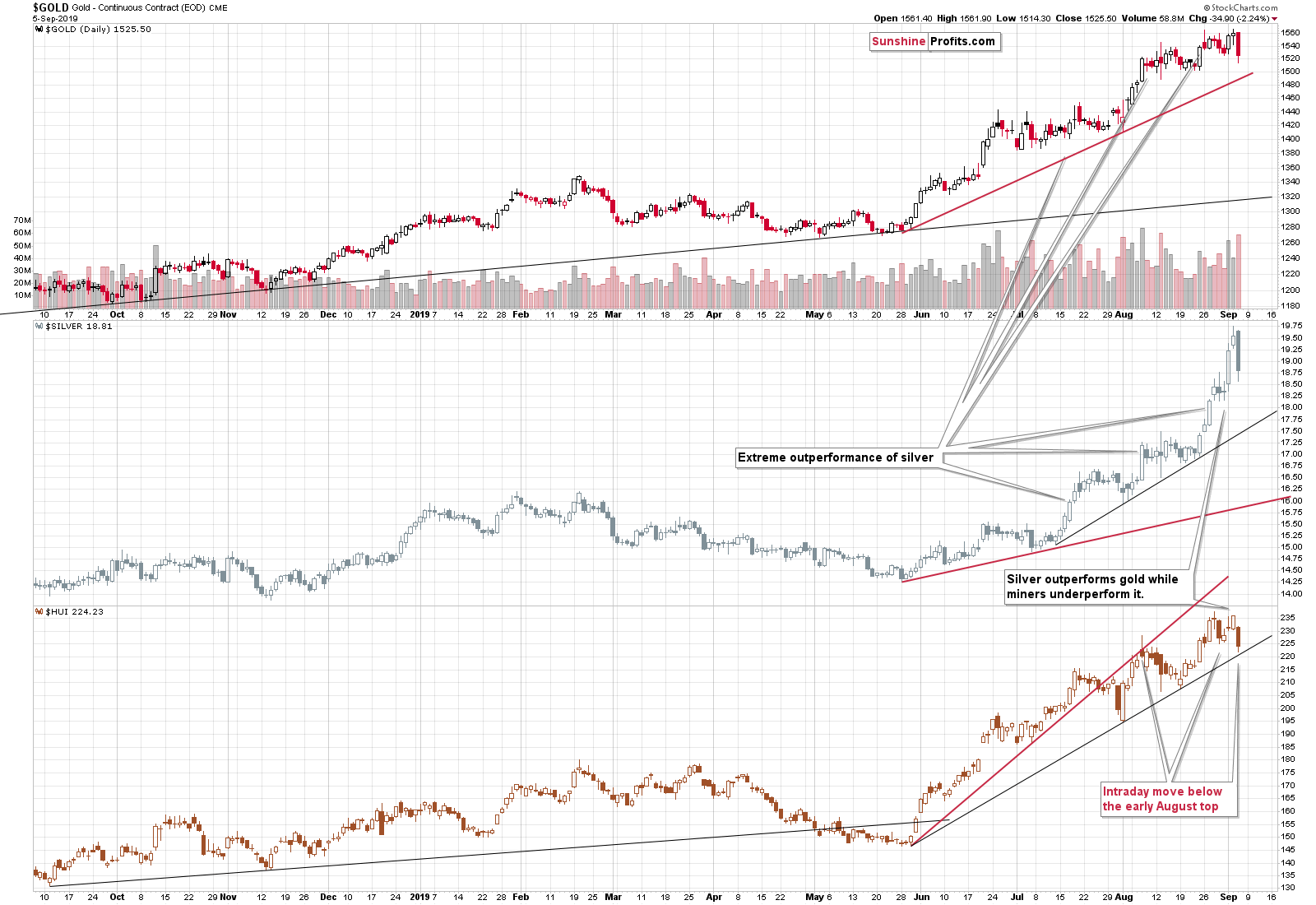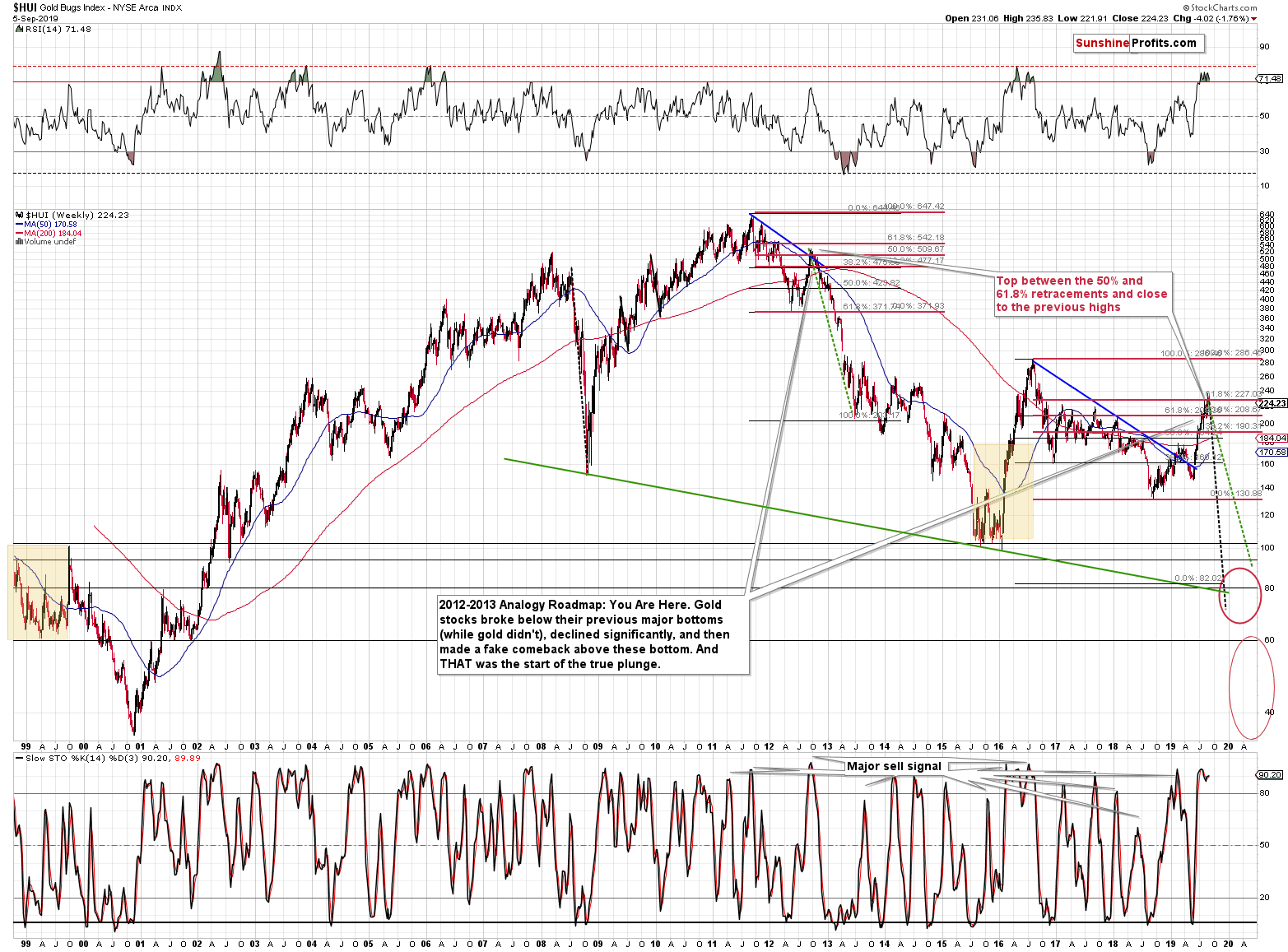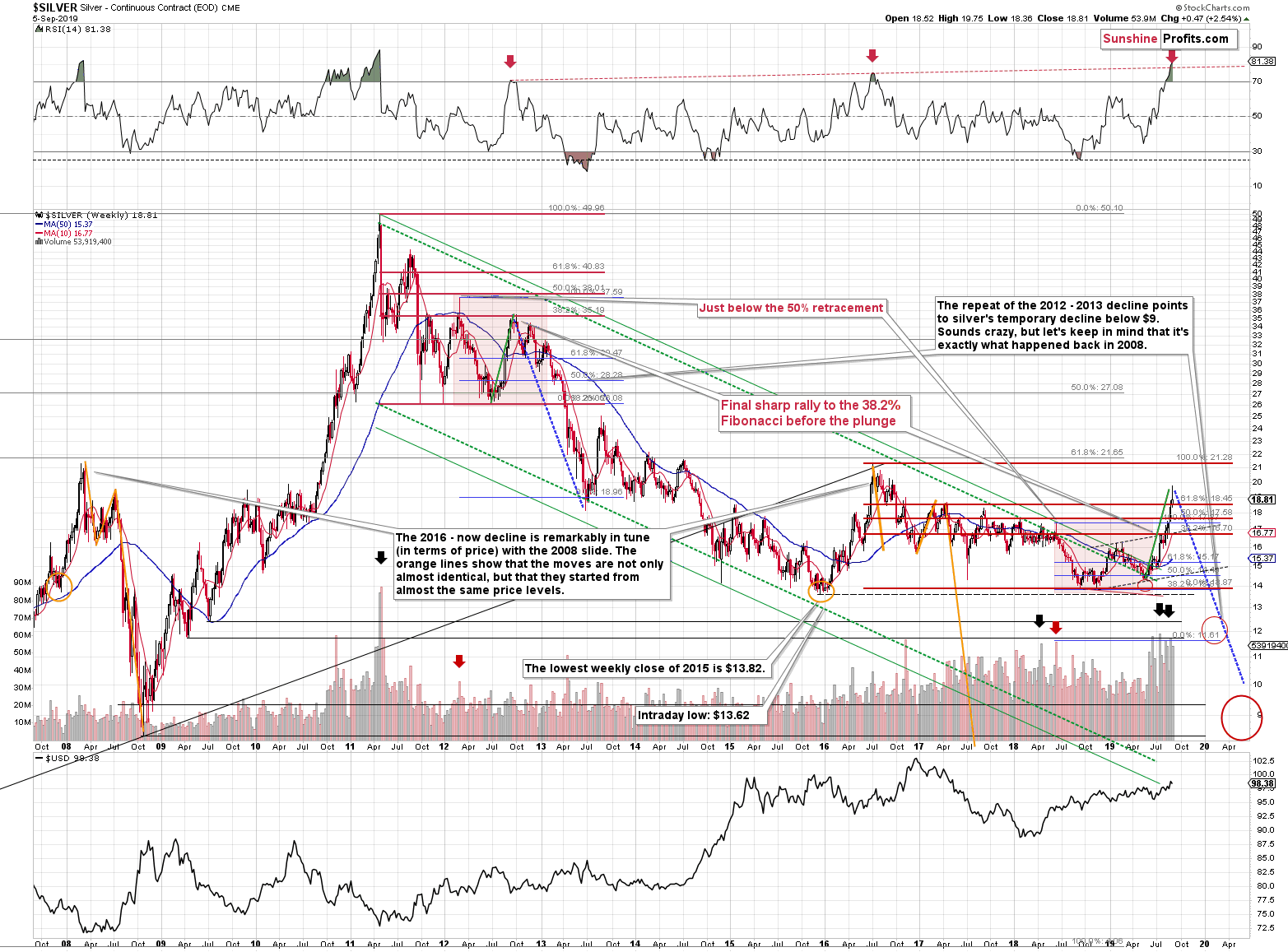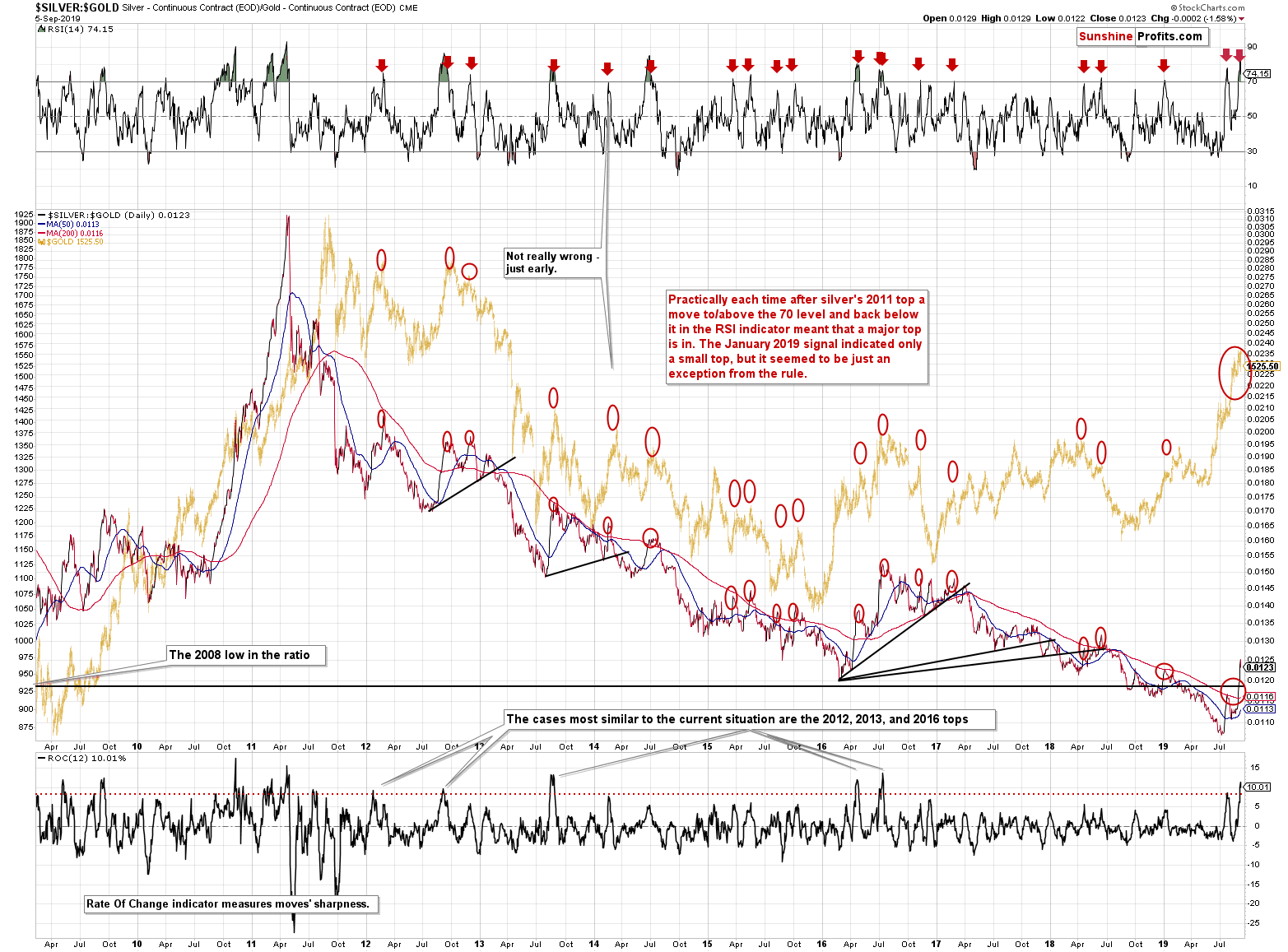Briefly: in our opinion, full (250% of the regular size of the position) speculative short position in gold, silver, and mining stocks are justified from the risk/reward point of view at the moment of publishing this Alert.
And so, the rally in gold and silver has come to an end. Of course, one can say that yesterday's slide was just a daily correction, or a pause, but this is not the case. There are myriads of reasons for it, but we want to emphasize two of them. First, gold and silver plunged without practically any daily price change in the USD Index. Second, the decline continues also today. Silver is already about 50 cents lower, proving that there's more to the plunge than just yesterday's move. Still, there is some truth to the saying that nothing major happened yesterday. In fact, it's completely true. Given the number and importance of the bearish factors in play, we can say that the declines of yesterday and today indeed are barely noticeable - that huge a decline is likely still ahead. So, yes, nothing really major happened... Yet.
Before moving to the price changes in the precious metals, let's take a look at the USD Index.
USD Index at Support
Nothing really changed yesterday, or today, which is important, because it means that there was no breakdown below the rising support line and thus that our previous comments on the above chart remain up-to-date:
The U.S. currency just rallied above the neck level of the medium-term inverse head-and-shoulders pattern, but it moved back below it in today's pre-market trading.
This means that the USDX could decline in the next few days, and confirm the breakout above the inverse head-and-shoulders pattern at its next attempt. The rising line provides support, which is currently at about 98.3. (...)
However, what is more important is that gold is declining today even without USD's help. This means that gold's rally might already be over even though the USD didn't successfully break above the neck level just yet. Once USDX confirms its breakout, gold's decline is likely to accelerate.
(...)
In today's pre-market trading, the USDX reached its rising support line, just like we described it. And what did gold do in light of this supposedly bullish factor? It declined about $10. In the last two days, the USD Index declined, and gold declined as well. Gold's resilience appears to be over.
Yesterday's session clearly confirmed the last sentence. This, plus USD's very bullish outlook for the following months - and perhaps years - means much lower gold prices on the horizon.
Having said that, let's take a look at PMs' performance.
Yesterday's PMs Plunge
Gold, silver, and mining stocks have all declined profoundly, and it seems to have been a very good decision to enter short positions in silver yesterday, while it was still trading at about $19.35. It's already more than $1 below this price.
However, as we wrote earlier, that's most likely nothing compared to what's to come.
Gold futures closed only a bit below the late-August lows and they are trading close to the mid-August lows so far today, so there was no major breakdown in gold just yet.
The same goes for silver - even though silver futures moved to about $18 in today's pre-market trading, there was no breakdown below the rising support line that currently provides support at about $17.50.
The HUI Index declined below the late August lows, but didn't slide below its rising support line so far either. Still, given today's pre-market slide in gold and silver, it appears that if even if gold and silver don't decline more today, the HUI will slide further. Gold moved below yesterday's lows, and silver's slide is even more profound. This means that the HUI is also likely to move below its yesterday's lows, perhaps significantly so. This, in turn, means a breakdown below the rising support line that's based on three previous lows. This breakdown will be an important confirmation of the bearish case in the short run.
The short-term breakdowns are not as important as what happened on the longer timeframes, though.
The Long-Term PMs Charts
And what happened, was that gold stocks have already invalidated their small breakout above the 61.8% Fibonacci retracement level and silver just did the same thing.
The above chart doesn't include today's decline yet - silver is currently (at the moment of writing these words) trading at $18.30, which is below the 61.8% Fibonacci retracement.
Two days ago, we commented on the above chart in the following way:
And while gold stocks have been underperforming gold...
Silver outperformed it. The white metal soared and closed the day visibly above the 61.8% Fibonacci retracement level. If it wasn't specifically silver that did this, it would be bullish. But it was silver - the metal known for fake moves right before turnarounds, especially when gold miners lag. (...)
Can silver's breakout be trusted this time? Well, it definitely can be trusted, but it shouldn't. The history is rich in examples that show how silver outperformed right before severe declines and the earlier-featured chart below proves it.
Those that do not specialize in the precious metals market, will often view silver's strong performance in the short run as something profoundly bullish. And if this means that silver is outperforming gold (just as it did recently), this is a sell sign in disguise. It's not intuitive and it's against some rules that apply to other markets, but that's just how the precious metals market works. If you ever feel that silver is about to take off as it's been outperforming gold on a short-term basis, rallying vertically etc., or you read an analysis or watch a video that claims so, please take a look at the above chart and count how many times per year - on average - gold and silver topped right after silver's short-term strength. This will help you put silver's rally into proper perspective.
The odds are that based on what we see today, the silver to gold ratio will decline once again, and the RSI based on it will decline as well. A move below 70 in the latter will serve as yet another sell confirmation.
Most importantly, however, the key factors that we outlined in the previous Alerts (especially the ones from the "critical" category), remain up-to-date.
Key Factors to Keep in Mind
Critical factors:
- The USD Index broke above the very long-term resistance line and verified the breakout above it. Its huge upswing is already underway.
- The USD's long-term upswing is an extremely important and bearish factor for gold. There were only two similar cases in the past few decades, when USD Index was starting profound, long-term bull markets, and they were both accompanied by huge declines in gold and the rest of the precious metals market
- Out of these two similar cases, only one is very similar - the case when gold topped in February 1996. The similarity extends beyond gold's about a yearly delay in reaction to the USD's rally. Also the shape of gold price moves prior to the 1996 high and what we saw in the last couple of years is very similar, which confirm the analysis of the gold-USD link and the above-mentioned implications of USD Index's long-term breakout.
- The similarity between now and 1996 extends to silver and mining stocks - in other words, it goes beyond USD, gold-USD link, and gold itself. The white metal and its miners appear to be in a similar position as well, and the implications are particularly bearish for the miners. After their 1996 top, they erased more than 2/3rds of their prices.
- Many investors got excited by the gold-is-soaring theme in the last few months, but looking beyond the short-term moves, reveals that most of the precious metals sector didn't show substantial strength that would be really visible from the long-term perspective. Gold doesn't appear to be starting a new bull market here, but rather to be an exception from the rule.
- Gold's True Seasonality around the US Labor Day points to a big decline shortly.
Very important, but not as critical factors:
- Long-term technical signs for silver, i.a. the analogy in terms of price to what we saw in 2008, shows that silver could slide even below $10.
- Silver's very long-term cycles point to a major reversal taking place right now and since the most recent move was up, the implications are bearish (this is also silver's technical sign, but it's so important that it deserves its own point)
- Long-term technical signs for gold stocks point to this not being a new gold bull market beginning. Among others, it's their long-term underperformance relative to gold that hint this is rather a corrective upswing within a bear market that is not over yet.
- Record-breaking weekly volume in gold is a strong sign pointing to lower gold prices
Important factors:
- Extreme volume reading in the SIL ETF (proxy for silver stocks) is an effective indication that lower values of silver miners are to be expected
- Silver's short-term outperformance of gold, and gold stocks' short-term underperformance of gold both confirm that the precious metals sector is topping here
- Gold topped almost right at its cyclical turning point, which makes the trend reversal more likely
- Copper broke below its head-and-shoulders pattern and confirmed the breakdown. The last time we saw something similar was in April 2013, when the entire precious metals sector was on the verge of plunging lower.
Moreover, please note that while there may be a recession threat, it doesn't mean that gold has to rally immediately. Both: recession and gold's multi-year rally could be many months away - comparing what happened to bond yields in the 90s confirms that.
Summary
Summing up, the big decline in the precious metals sector appears to be finally underway as gold and silver are plunging even without a rallying USD Index. Once the latter takes off, it will likely serve as fuel to the fire-like decline that's already underway. The similarity to mid-90s continues to support much lower gold prices in the following months, and the True Seasonal patterns continues to favor lower gold prices in the following weeks. All in all, it seems that what we see right now is the beginning of the end of the prolonged decline in the precious metals sector that started in 2011. On a short-term basis, it seems that we might get some temporary strength once gold moves to about $1,330 - perhaps within the next few weeks.
We are adjusting our profit-take and stop-loss levels for mining stocks and related ETNs, in order to take advantage of short-term decline in gold to about $1,330.
As always, we'll keep you - our subscribers - informed.
To summarize:
Trading capital (supplementary part of the portfolio; our opinion): Full speculative short position (250% of the full position) in gold, silver, and mining stocks is justified from the risk/reward perspective with the following stop-loss orders and exit profit-take price levels:
- Gold: profit-take exit price: $1,332; stop-loss: $1,583; initial target price for the DGLD ETN: $39.87; stop-loss for the DGLD ETN: $25.17
- Silver: profit-take exit price: $14,62; stop-loss: $20,16; initial target price for the DSLV ETN: $32.96; stop-loss for the DSLV ETN: $11.67
- Mining stocks (price levels for the GDX ETF): profit-take exit price: $22.62; stop-loss: $32.37; initial target price for the DUST ETF: $17.28; stop-loss for the DUST ETF $5.48
In case one wants to bet on junior mining stocks' prices (we do not suggest doing so - we think senior mining stocks are more predictable in the case of short-term trades - if one wants to do it anyway, we provide the details), here are the stop-loss details and target prices:
- GDXJ ETF: profit-take exit price: $30.32; stop-loss: $45.42
- JDST ETF: profit-take exit price: $38.36 stop-loss: $11.26
Long-term capital (core part of the portfolio; our opinion): No positions (in other words: cash)
Insurance capital (core part of the portfolio; our opinion): Full position
Whether you already subscribed or not, we encourage you to find out how to make the most of our alerts and read our replies to the most common alert-and-gold-trading-related-questions.
Please note that the in the trading section we describe the situation for the day that the alert is posted. In other words, it we are writing about a speculative position, it means that it is up-to-date on the day it was posted. We are also featuring the initial target prices, so that you can decide whether keeping a position on a given day is something that is in tune with your approach (some moves are too small for medium-term traders and some might appear too big for day-traders).
Plus, you might want to read why our stop-loss orders are usually relatively far from the current price.
Please note that a full position doesn't mean using all of the capital for a given trade. You will find details on our thoughts on gold portfolio structuring in the Key Insights section on our website.
As a reminder - "initial target price" means exactly that - an "initial" one, it's not a price level at which we suggest closing positions. If this becomes the case (like it did in the previous trade) we will refer to these levels as levels of exit orders (exactly as we've done previously). Stop-loss levels, however, are naturally not "initial", but something that, in our opinion, might be entered as an order.
Since it is impossible to synchronize target prices and stop-loss levels for all the ETFs and ETNs with the main markets that we provide these levels for (gold, silver and mining stocks - the GDX ETF), the stop-loss levels and target prices for other ETNs and ETF (among other: UGLD, DGLD, USLV, DSLV, NUGT, DUST, JNUG, JDST) are provided as supplementary, and not as "final". This means that if a stop-loss or a target level is reached for any of the "additional instruments" (DGLD for instance), but not for the "main instrument" (gold in this case), we will view positions in both gold and DGLD as still open and the stop-loss for DGLD would have to be moved lower. On the other hand, if gold moves to a stop-loss level but DGLD doesn't, then we will view both positions (in gold and DGLD) as closed. In other words, since it's not possible to be 100% certain that each related instrument moves to a given level when the underlying instrument does, we can't provide levels that would be binding. The levels that we do provide are our best estimate of the levels that will correspond to the levels in the underlying assets, but it will be the underlying assets that one will need to focus on regarding the signs pointing to closing a given position or keeping it open. We might adjust the levels in the "additional instruments" without adjusting the levels in the "main instruments", which will simply mean that we have improved our estimation of these levels, not that we changed our outlook on the markets. We are already working on a tool that would update these levels on a daily basis for the most popular ETFs, ETNs and individual mining stocks.
Our preferred ways to invest in and to trade gold along with the reasoning can be found in the how to buy gold section. Additionally, our preferred ETFs and ETNs can be found in our Gold & Silver ETF Ranking.
As a reminder, Gold & Silver Trading Alerts are posted before or on each trading day (we usually post them before the opening bell, but we don't promise doing that each day). If there's anything urgent, we will send you an additional small alert before posting the main one.
Thank you.
Sincerely,
Przemyslaw Radomski, CFA
Editor-in-chief, Gold & Silver Fund Manager


